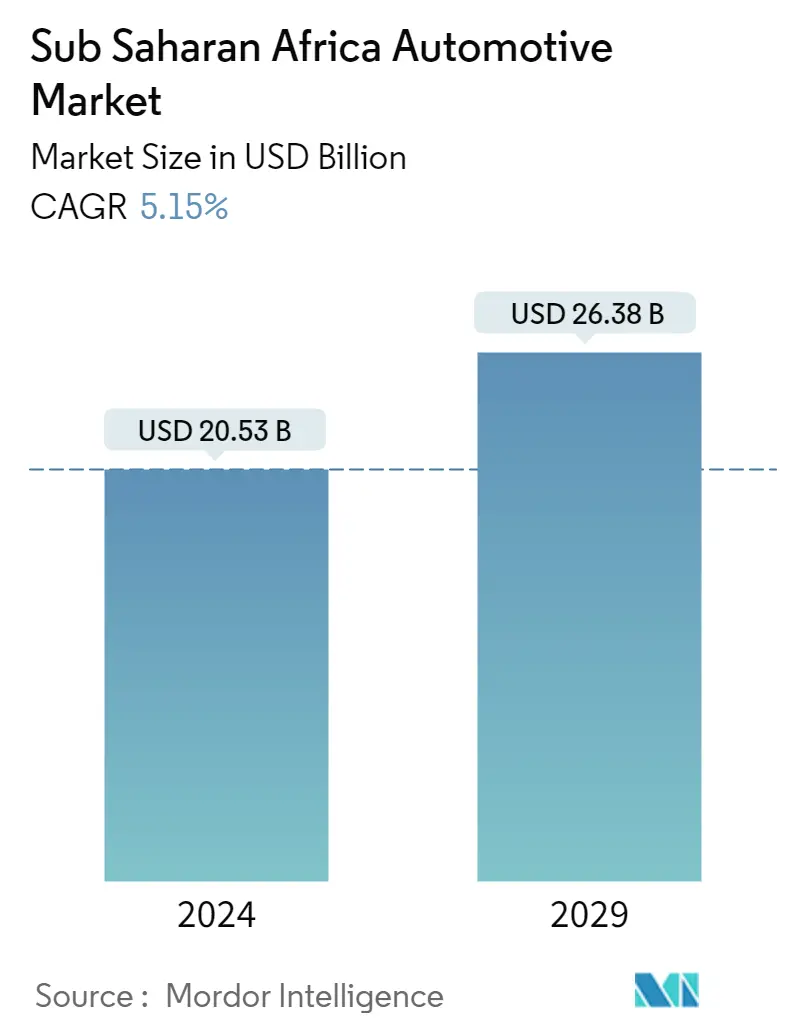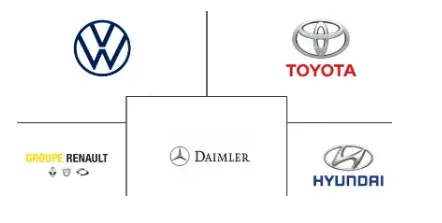Market Size of Sub Saharan Africa Automotive Industry

| Study Period | 2019 - 2029 |
| Base Year For Estimation | 2023 |
| Market Size (2024) | USD 20.53 Billion |
| Market Size (2029) | USD 26.38 Billion |
| CAGR (2024 - 2029) | 5.15 % |
| Market Concentration | Medium |
Major Players
*Disclaimer: Major Players sorted in no particular order |
Africa Automotive Market Analysis
The Sub Saharan Africa Automotive Market size is estimated at USD 20.53 billion in 2024, and is expected to reach USD 26.38 billion by 2029, growing at a CAGR of 5.15% during the forecast period (2024-2029).
The COVID-19 pandemic had a significant impact on the market, and demand is still lagging behind pre-COVID levels. Until 2018, the demand for new vehicles in the African region increased. However, governments across the region are taking initiatives to boost the automotive industry by implementing a ban on imported used vehicles. According to the data from the National Automotive Design and Development Council (NADDC), Nigeria spends about NGN 2.88 trillion (USD 8 billion) on the importation of about 300,000 to 400,000 cars, yearly.
Over the medium term, some governments in Sub-Saharan Africa have begun to announce vehicle electrification targets and incentives for EV adoption, such as Rwanda's tax exemptions for EV sales. Furthermore, a burgeoning start-up ecosystem for EVs, with a focus on electric two-wheelers, is emerging in the region. According to automotive experts, there were more than 20 start-ups in the ecosystem at the end of 2021, with total funding of more than $25 million that year.
Additionally, to discourage the importation of vehicles and encourage local vehicle production, Nigeria slammed 70% import duty and levied on imported vehicles. This resulted in increased volume of locally assembled and manufactured vehicles in the country and most of the local companies have seen developments in their manufacturing process and capacity. For instance,
- Innoson Vehicles Manufacturing Limited (IVM) opened a new automated plant for manufacturing bus at Nnewi, Anambra State, in 2019. The automated plant reduced the cost of new 15-17-seater Hummer bus from NGN 16 million to NGN 9 million.
However, Due to low disposable income and very high cost associated with new vehicles, used vehicles dominate some of sub-saharan countries automotive retail sector. These vehicles are mainly imported from regions with low resale or residual values of used vehicles like Europe, Japan, and the United States. This might hamper the target market during the forecasted timeperiod.
Africa Automotive Industry Segmentation
The Sub-Saharan automotive market outlook examines the region's growing demand for passenger cars, commercial vehicles, and two-wheelers, OEM investments to establish a presence in countries, developments in the electric vehicle market, and market shares of both OEMs and OES. Regulations on importing new and used vehicles, taxes levied by the government for new & used vehicles, government initiatives to boost the automotive industry, and the future of the Sub-Saharan Africa Automotive industry.
The Sub-Saharan Africa Automotive market is segmented by Body Style Type, Fuel Type, Vehicle Type, and Geography.
By Body Style Type, the market is segmented into Hatchback, Sedan, Sport Utility Vehicles, and Others. BY Fuel Type, the market is segmented into Gasoline, Diesel, and Other Alternative Fuels. By Vehicle Type, the market is segmented into Passenger Cars, Commercial Vehicles, and Two-wheelers. By Geography, the market is segmented into South Africa, Kenya, Nigeria, Ethiopia, Ghana, and Other Countries. For each segment, the market size, and forecast have been done on basis of value (USD million).
| Body Style Type | |
| Hatchback | |
| Sedan | |
| Sports Utility Vehicles | |
| Others (Mini-vans, MPV, etc.) |
| By Vehicle Type | |
| Passenger Cars | |
| Commercial Vehicles |
| By Fuel Type | |
| Gasoline | |
| Diesel | |
| Other Alternative Fuels |
| Country | |
| South Africa | |
| Nigeria | |
| Kenya | |
| Ethiopia | |
| Ghana | |
| Other Countries (Tanzania, Angola, Zambia, etc. ) |
Sub Saharan Africa Automotive Market Size Summary
The Sub-Saharan Africa automotive market is poised for growth, driven by government initiatives and a burgeoning electric vehicle ecosystem. Efforts to boost local production include bans on imported used vehicles and significant import duties, which have spurred the development of local manufacturing capabilities. Countries like Nigeria have seen increased volumes of locally assembled vehicles, with companies such as Innoson Vehicles Manufacturing Limited expanding their production facilities. The region is also witnessing a rise in electric vehicle adoption, supported by incentives like tax exemptions in Rwanda and a growing start-up scene focused on electric two-wheelers. However, challenges such as low disposable income and the dominance of used vehicles, primarily imported from regions with low resale values, continue to impact the market.
Infrastructure improvements and economic growth aspirations, particularly in countries like Ghana, are expected to further drive the automotive market's expansion. The South African automotive industry, while adapting to market forces and economic uncertainties, remains a key player with leading manufacturers like Volkswagen, Toyota, and Nissan dominating the market. Recent developments include new vehicle launches and cosmetic upgrades, as well as strategic commitments from manufacturers like Volkswagen to expand operations in Nigeria. Despite challenges such as fluctuating vehicle interest rates and rising costs, the region's automotive sector is evolving, with a focus on sustainable mobility and local production capabilities.
Sub Saharan Africa Automotive Market Size - Table of Contents
-
1. MARKET DYNAMICS
-
1.1 Market Drivers
-
1.2 Market Restraints
-
1.3 Industry Attractiveness - Porter's Five Force Analysis
-
1.3.1 Threat of New Entrants
-
1.3.2 Bargaining Power of Buyers/Consumers
-
1.3.3 Bargaining Power of Suppliers
-
1.3.4 Threat of Substitute Products
-
1.3.5 Intensity of Competitive Rivalry
-
-
-
2. MARKET SEGMENTATION
-
2.1 Body Style Type
-
2.1.1 Hatchback
-
2.1.2 Sedan
-
2.1.3 Sports Utility Vehicles
-
2.1.4 Others (Mini-vans, MPV, etc.)
-
-
2.2 By Vehicle Type
-
2.2.1 Passenger Cars
-
2.2.2 Commercial Vehicles
-
-
2.3 By Fuel Type
-
2.3.1 Gasoline
-
2.3.2 Diesel
-
2.3.3 Other Alternative Fuels
-
-
2.4 Country
-
2.4.1 South Africa
-
2.4.2 Nigeria
-
2.4.3 Kenya
-
2.4.4 Ethiopia
-
2.4.5 Ghana
-
2.4.6 Other Countries (Tanzania, Angola, Zambia, etc. )
-
-
Sub Saharan Africa Automotive Market Size FAQs
How big is the Sub Saharan Africa Automotive Market?
The Sub Saharan Africa Automotive Market size is expected to reach USD 20.53 billion in 2024 and grow at a CAGR of 5.15% to reach USD 26.38 billion by 2029.
What is the current Sub Saharan Africa Automotive Market size?
In 2024, the Sub Saharan Africa Automotive Market size is expected to reach USD 20.53 billion.

